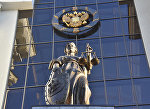MOSCOW, October 12 - RAPSI, Ingrid Burke. The US Federal Court of Appeals for the Federal Circuit reversed and remanded Thursday a district court decision that had enjoined the sale of Samsung’s Galaxy Nexus smartphone based on an alleged patent infringement. The appellate court held that the district court abused its discretion and misapplied the law in granting the injunction.
At the heart of the appeal was the particular patent associated with Apple’s popular iPhone 4S app, Siri. Siri has been described by Apple as an “intelligent personal assistant.” The app enables iPhone 4S users to ask questions of their phones as they would a natural person.
The Siri patent was one of eight that Apple alleged Samsung had infringed upon in its initial claim, but was the only patent at issue in this appeal as it had served as the basis for the district court’s decision to enjoin Samsung from selling the Galaxy Nexus, which features a comparable technology called the Quick Search Box (QSB).
The patented technology at issue is “an apparatus for ‘unified search’ that uses heuristic modules to search multiple data storage locations.” Specifically, a user enters a search term into his smartphone’s unified search interface. The term is then submitted to different heuristic modules, each of which is associated with a predetermined search area. The accumulated results are then displayed on the smartphone.
This is the technology that fuels Siri.
Apple alleged that the QSB unified search application found on Samsung’s Galaxy Nexus infringes upon the Siri patent.
In order to attain a preliminary injunction, a plaintiff must prove four elements: the likelihood of success on the merits, the likelihood that irreparable harm would result if not for preliminary relief, the balance of equities must tip in the plaintiff’s favor, and the public interest benefit of a preliminary injunction. Samsung challenged the court’s findings on Apple’s establishment of the irreparable harm and likelihood of success elements.
To satisfy the irreparable harm element, Apple was required to show a “likelihood of substantial and immediate irreparable injury” pending the court’s refusal to enjoin its competitor’s sales. Where the infringing product at issue is one that includes numerous features, such as the Galaxy Nexus smartphone, the plaintiff’s burden of proof is slightly higher in this regard. In such cases, the plaintiff must further prove the existence of a causal nexus. In other words, he must prove that a “sufficiently strong causal nexus relates the alleged harm to the alleged infringement.”
The district court supported Apple’s argument that the sale of the Galaxy Nexus would cause the imminent threat of irreparable harm, and that such harm bore a strong causal relationship to Samsung’s alleged infringement of the Siri technology.
To this the appellate court held that the district court “abused its discretion in determining that Apple established a sufficient causal nexus.” It further asserted that, “to the extent the district court endorsed Apple’s articulation of the causal nexus test, it erred as a matter of law.”
The appellate court reasoned that it is necessary when considering a causal nexus analysis to ensure that injunctive relief would truly derail the course of encroaching irreparable harm, rather than serving merely as a means for the plaintiff to derail his competitor’s sales.
Thus, the appellate court asserted that, “It is not enough for the patentee to establish some insubstantial connection between the alleged harm and the infringement and check the causal nexus requirement off the list. The patentee must rather show that the infringing feature drives consumer demand for the accused product. Only viewed through the prism of the causal nexus analysis will the irreparable harm allegations reflect a realistic sense of what the patentee has at stake.”
The appellate court found that Apple had gathered only limited evidence of a causal nexus, and that it failed to present any evidence directly tying consumer demand for the Galaxy Nexus to its QSB feature.
Furthermore, the appellate court reasoned that the QSB simply does not match up to Siri: “There is no dispute that this highly popular feature is a significant source of consumer demand for the iPhone 4S. There is also no dispute, however, that the Galaxy Nexus does not have a feature equivalent to Siri.”
In sum, Apple failed to fulfill the causal nexus analysis by failing to establish that consumer desire for the Galaxy Nexus was driven by its QSB, and the district court failed to properly consider the analysis as evidenced by the fact that it made no determination of whether consumer demand for the competitor smartphone centered on the existence of the QSB.
In closing the irreparable harm section of its analysis, the court concluded that, “Regardless of the extent to which Apple may be injured by the sales of the Galaxy Nexus, there is not a sufficient showing that the harm flows from Samsung’s alleged infringement. Thus, the district court abused its discretion in determining that the irreparable harm factor counsels in favor of entering an injunction.”
The appellate court further held that the district court erred in establishing - in light of its grant of preliminary relief - that Apple adequately proved its claim would have succeeded on the merits.


